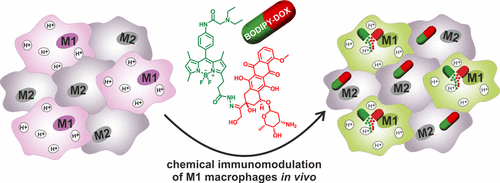当前位置:
X-MOL 学术
›
ACS Cent. Sci.
›
论文详情
Our official English website, www.x-mol.net, welcomes your feedback! (Note: you will need to create a separate account there.)
Chemical Modulation of in Vivo Macrophage Function with Subpopulation-Specific Fluorescent Prodrug Conjugates.
ACS Central Science ( IF 18.2 ) Pub Date : 2017-08-30 , DOI: 10.1021/acscentsci.7b00262 Antonio Fernandez 1 , Matthieu Vermeren 1 , Duncan Humphries 1 , Ramon Subiros-Funosas 1 , Nicole Barth 1 , Lara Campana 2 , Alison MacKinnon 1 , Yi Feng 1 , Marc Vendrell 1
ACS Central Science ( IF 18.2 ) Pub Date : 2017-08-30 , DOI: 10.1021/acscentsci.7b00262 Antonio Fernandez 1 , Matthieu Vermeren 1 , Duncan Humphries 1 , Ramon Subiros-Funosas 1 , Nicole Barth 1 , Lara Campana 2 , Alison MacKinnon 1 , Yi Feng 1 , Marc Vendrell 1
Affiliation

|
Immunomodulatory agents represent one of the most promising strategies for enhancing tissue regeneration without the side effects of traditional drug-based therapies. Tissue repair depends largely on macrophages, making them ideal targets for proregenerative therapies. However, given the multiple roles of macrophages in tissue homeostasis, small molecule drugs must be only active in very specific subpopulations. In this work, we have developed the first prodrug-fluorophore conjugates able to discriminate closely related subpopulations of macrophages (i.e., proinflammatory M1 vs anti-inflammatory M2 macrophages), and employed them to deplete M1 macrophages in vivo without affecting other cell populations. Selective intracellular activation and drug release enabled simultaneous fluorescence cell tracking and ablation of M1 macrophages in vivo, with the concomitant rescue of a proregenerative phenotype. Ex vivo assays in human monocyte-derived macrophages validate the translational potential of this novel platform to develop chemical immunomodulatory agents as targeted therapies for immune-related diseases.
中文翻译:

用亚群特异性荧光前药偶联物对体内巨噬细胞功能进行化学调节。
免疫调节剂代表了在没有传统药物疗法副作用的情况下增强组织再生的最有希望的策略之一。组织修复很大程度上依赖于巨噬细胞,使其成为再生疗法的理想目标。然而,鉴于巨噬细胞在组织稳态中的多重作用,小分子药物必须仅在非常特定的亚群中发挥作用。在这项工作中,我们开发了第一个能够区分密切相关的巨噬细胞亚群(即促炎 M1 与抗炎 M2 巨噬细胞)的前药-荧光团偶联物,并利用它们在体内消耗 M1 巨噬细胞而不影响其他细胞群。选择性细胞内激活和药物释放能够同时进行荧光细胞追踪和体内 M1 巨噬细胞的消融,伴随着对前再生表型的拯救。人单核细胞衍生巨噬细胞的离体检测验证了这一新平台的转化潜力,可开发化学免疫调节剂作为免疫相关疾病的靶向治疗。
更新日期:2017-08-30
中文翻译:

用亚群特异性荧光前药偶联物对体内巨噬细胞功能进行化学调节。
免疫调节剂代表了在没有传统药物疗法副作用的情况下增强组织再生的最有希望的策略之一。组织修复很大程度上依赖于巨噬细胞,使其成为再生疗法的理想目标。然而,鉴于巨噬细胞在组织稳态中的多重作用,小分子药物必须仅在非常特定的亚群中发挥作用。在这项工作中,我们开发了第一个能够区分密切相关的巨噬细胞亚群(即促炎 M1 与抗炎 M2 巨噬细胞)的前药-荧光团偶联物,并利用它们在体内消耗 M1 巨噬细胞而不影响其他细胞群。选择性细胞内激活和药物释放能够同时进行荧光细胞追踪和体内 M1 巨噬细胞的消融,伴随着对前再生表型的拯救。人单核细胞衍生巨噬细胞的离体检测验证了这一新平台的转化潜力,可开发化学免疫调节剂作为免疫相关疾病的靶向治疗。



























 京公网安备 11010802027423号
京公网安备 11010802027423号